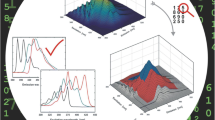Abstract
X-irradiated carbonated apatites precipitated from aqueous solutions and dried at 400°C until constant weight are investigated with electron paramagnetic resonance (EPR). The carbonate content of the samples studied ranges from 8.12 to 21.0 wt%. The observed multicomponent EPR spectra are analyzed with maximum likelihood common factor analysis (MLCFA), a multivariate statistical technique. Once the correct number of constituents are determined and the factor spectra estimated by MLCFA, a minimization procedure is performed in order to transform the abstract factor spectra linearly into an equal number of real EPR powder spectra. The spin hamiltonian parameters of the component spectra thus obtained are used to characterize and identify the different paramagnetic radicals. A comparison with values from the literature is made. A spectrum decomposition study of all the observed multicomponent EPR spectra in terms of the isolated constituents is successfully performed as a function of the carbonate content of the samples.
Similar content being viewed by others
References
Cevc P, Schara M (1972) Electron paramagnetic resonance study of irradiated tooth enamel. Radiat Res. 51:581–589
Ostrowski K, Dziedzic-Goclawska A, Stachowicz W, Michalik J (1973) Application of electron spin resonance in research on mineralized tissues. Clin Orthop. 97:213–224
Peckauskas RA, Pullman I (1978) Radiogenic free radicals as molecular probes in bone. Calcif Tissue Res. 25:37–45
Sato R (1979) Study of an assymmetric ESR signal in X-irradi-ated human tooth enamel. Calcif Tissue Int. 29:95–99
Doi Y, Aoba T, Okazaki M, Takahashi J, Moriwaki Y (1981) 13C Enriched carbonate apatites studies by ESR: comparison with human tooth enamel apatites. Calcif Tissue Int. 33:81–92
Doi Y, Moriwaka Y, Aoba T, Okazaki M, Takahashi J, Joshin K (1982) Carbonate apatites from aqueous and non-aqueous media studied by ESR, IR and X-ray diffraction: effect of NH4+ ions on crystallographic parameters. J Dent Res. 61:429–434
Callens FJ, Verbeeck RMH, Naessens DE, Matthys PFA, Boesman ER (1989) Effect of carbonate content on the ESR spectrum near g = 2 of carbonated calciumapatites synthesized from aqueous media. Calcif Tissue Int. 44:114–124
Callens FJ, Verbeeck RMH, Naessens DE, Matthys PFA, Boesman ER (1991) The effect of carbonate content and drying temperature on the ESR spectrum near g = 2 of carbonated calciumapatites synthesized from aqueous media. Calcif Tissue Int. 48:249–259
Callens FJ, Verbeeck RMH, Naessens DE, Matthys PFA, Boesman ER (in press) ESR study of 13C enriched carbonated calciumapatites precipitated from aqueous solutions. Calcif Tissue Int
Moens P, De Voider P, Hoogewijs R, Callens F, Verbeeck R (1993) Maximum-likelihood common-factor analysis as a powerful tool in decomposing multicomponent EPR powder spectra. J Magn Reson 101 A: 1–15
Driessens FCM, Verbeeck RMH (1990) Biominerals. CRC Press, Boca Raton
LeGeros RZ, LeGeros JP, Trautz OR, Shirra WP (1971) Conversion of monetite, CaHPO4, to apatites: effect of carbonate on the crystallinity and the morphology of the apatite crystallites. Adv X-ray Anal. 14:57–66
Naessens DE, Verbeeck RMH, De Maeyer EAP (in press) Optimalization of the preparation of Na+- and CO2--containing hydroxyapatite under homogeneous precipitation conditions. Bull Soc Chim Belg
Joreskog KG, Lawley DN (1968) New methods in maximumlikelihood factor analysis. Br J Math Stat Psychol. 21:85–96
Fletcher R, Powell MJD (1963) A rapidly convergent descent method for minimization. Comput J. 2:90–97
Malinowski ER, Howery DG (1980) Factor analysis in chemistry. John Wiley, New York
Thomson GH (1951) The factorial analysis of human ability. University Press, London
Gaarenstroom SW (1981) Principal component analysis of Auger line shapes at solid-solid interfaces. Appl Surf Sci. 7:7–18
De Voider P, Hoogewijs R, De Gryse R, Fiermans L, Vennik J (1991) Maximum-likelihood common factor analysis in Auger electron spectroscopy. Surface Interface analysis. 17:363–372
Rey C, Collins B, Goehl T, Dickson IR, Glimcher MJ (1989) The carbonate environment in bone mineral: a resolution-enhanced Fourier transform infrared spectroscopy study. Calcif Tissue Int. 45:157–164
Bacquet G, Quang Truong V, Vignoles M, Trombe JC, Bonel G (1981) ESR of CO2“ in X-irradiated tooth enamel and A-type carbonated apatite. Calcif Tissue Int. 33:105–109
Geoffroy M, Tochon-Danguy HJ (1985) Long-lived radicals in irradiated apatites of biological interest: an ESR study of apatite samples treated with 13CO2. Int J Radiat Biol. 48:621–633
Moens P, Callens F, Verbeeck R, Naessens D, Matthys P, Maes F (1991) Adsorption of carbonate-derived molecules on the surface of carbonate-containing apatites. J Chem Faraday Trans. 87:3137–3142
Mikheikin ID, Zhidomiroc GM, Chuvylkin ND, Kazanskii VB (1972) Parameters of the ESR spectra and structure of radicals. J Struct Chem. 15:661–678
Acknowledgment
This work forms part of a project supported by the ‘Executieve van de Vlaamse Gemeenschap—Departement Onderwijs’ which is gratefully acknowledged.
Author information
Authors and Affiliations
Rights and permissions
About this article
Cite this article
Moens, P.D.W., Verbeeck, R.M.H., De Volder, P.J. et al. Spectrum Decomposition through Maximum Likelihood Common Factor Analysis of the EPR Spectra of Na+ Containing Carbonated Apatites Dried at 400°C. Calcif Tissue Int 53, 416–423 (1993). https://doi.org/10.1007/BF03549785
Received:
Accepted:
Published:
Issue Date:
DOI: https://doi.org/10.1007/BF03549785




